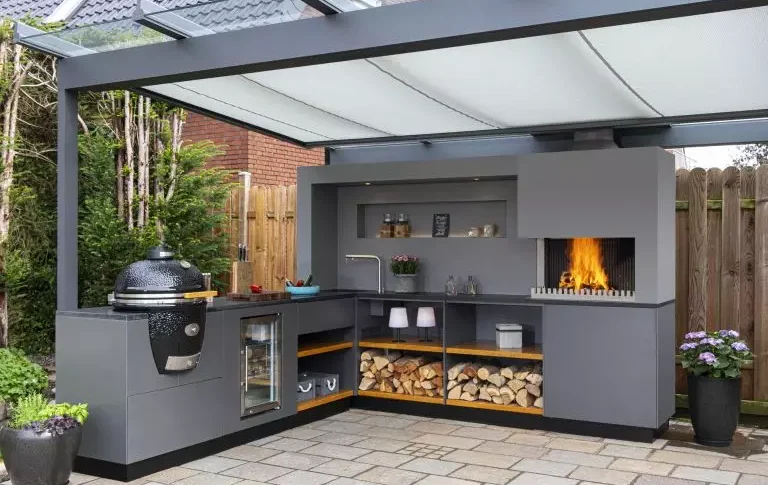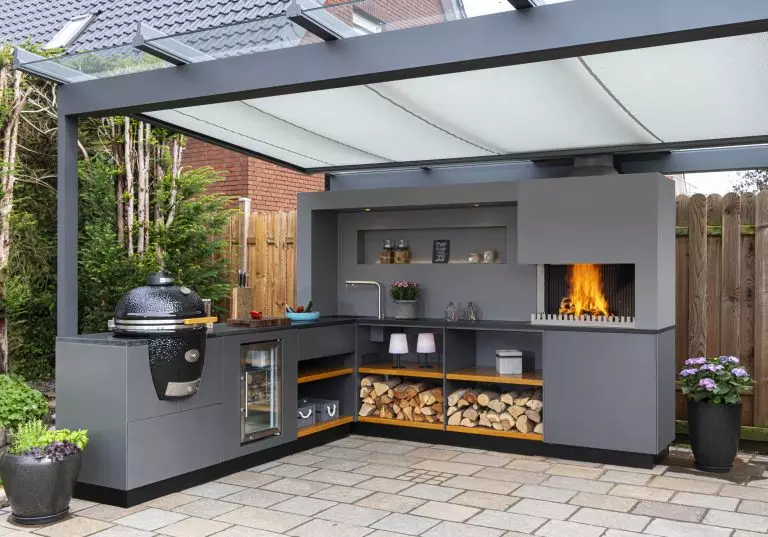
Creating an outdoor kitchen is an exciting way to elevate your outdoor space and enjoy cooking in the fresh air. Whether you want a small barbecue area or a fully equipped outdoor culinary haven, thoughtful planning will make your kitchen both functional and beautiful. In this blog, we’ll walk you through essential outdoor kitchen design ideas and tips to help you create the perfect setup for your needs.

1. Planning the Layout
The layout is the foundation of a great outdoor kitchen. Depending on your available space, budget, and cooking preferences, choose the most suitable design for your kitchen. Here are a few popular outdoor kitchen layouts:
a) Linear (Straight-Line) Layout
This is a simple and space-efficient layout with all components aligned along one wall. It’s ideal for smaller backyards or patios and works well when you need only basic cooking appliances, such as a grill and a countertop.
b) L-Shaped Layout
The L-shaped layout offers more countertop space and additional storage, perfect for those who want to include multiple cooking zones. The corner setup divides cooking and serving areas, making it easier to interact with guests while preparing meals.
c) U-Shaped Layout
If you have ample space, a U-shaped kitchen provides plenty of room for cooking, dining, and entertaining. This layout maximizes storage and workspace, creating dedicated zones for prep, cooking, and cleaning.
d) Island Layout
The island design revolves around a central cooking station and is ideal for hosting guests. Add bar seating around the island for a social atmosphere where people can gather around the chef.
Tip: Ensure there’s a proper flow between cooking, serving, and cleaning zones for an ergonomic experience. This concept, often called the kitchen work triangle, ensures minimal movement between the grill, sink, and fridge.
2. Choosing the Right Appliances and Equipment
Outdoor kitchens can be as basic or elaborate as you want. The key is to choose the right appliances based on how you intend to use the space.
a) Grills and Smokers
- Gas Grills: Quick, efficient, and easy to use. Perfect for those who prefer convenience.
- Charcoal Grills: Add a smoky flavor to your dishes. They take more time to heat, but many BBQ lovers prefer the taste.
- Smokers: Ideal for slow cooking meats with deep flavors. If you’re passionate about BBQ, a smoker is a must-have.
b) Pizza Ovens
Adding a pizza oven offers a fun, interactive experience. Outdoor pizza ovens come in wood-fired, gas, or electric models, perfect for baking pizzas, bread, and more.
c) Outdoor Refrigerators
Having a small refrigerator or beverage cooler keeps your ingredients and drinks cold without needing constant trips inside. Look for a model that can withstand outdoor elements.
d) Sinks and Dishwashers
A sink adds convenience by making it easier to clean up while cooking. If you’re building a large outdoor kitchen, consider a dishwasher to handle the dishes efficiently.
3. Durable Materials for Outdoor Use
Since outdoor kitchens are exposed to the elements, it’s essential to use materials that are both durable and weather-resistant.
a) Countertops
Choose materials that can withstand heat, UV rays, and moisture. Some popular options include:
- Granite: Scratch- and heat-resistant, making it a popular choice for outdoor countertops.
- Concrete: Offers a modern look and can be customized with various finishes.
- Quartzite: A natural stone that resists UV damage better than quartz.
- Stainless Steel: Durable and hygienic, though it may heat up quickly under the sun.
b) Cabinetry
Outdoor kitchen cabinets need to endure moisture, sun, and temperature changes. Common materials include:
- Stainless Steel: Rust-resistant and sleek but can get hot under direct sunlight.
- Marine-Grade Polymer: Resistant to water and UV rays, perfect for wet climates.
- Teak or Cedar: If you prefer wood, choose rot-resistant varieties. Proper sealing is necessary to maintain their appearance.
c) Flooring
Select non-slip, weatherproof flooring materials that complement the design of your kitchen. Some excellent options include:
- Concrete Pavers: Durable and available in many colors and textures.
- Natural Stone: Elegant but requires sealing to prevent stains.
- Porcelain Tiles: Slip-resistant options are great for outdoor use.
4. Creating Comfortable Seating and Dining Areas
An outdoor kitchen is more than just a place to cook. It’s a social hub where family and friends gather. Incorporating comfortable seating areas is essential for entertaining.
a) Bar Seating
Adding bar stools along a counter or island gives your guests a place to sit and chat while you cook. Choose stools with weatherproof cushions for added comfort.
b) Dining Tables and Chairs
A dedicated dining area with a large table and chairs ensures that everyone can enjoy meals together. Opt for weather-resistant furniture made from teak, aluminum, or synthetic wicker.
c) Lounge Areas
Incorporate a small lounge area with sofas, fire pits, or outdoor rugs to create a cozy vibe. You can also install pergolas or shade sails for added comfort.
5. Weather Protection and Shade Solutions
Weather can be unpredictable, so it’s essential to protect your outdoor kitchen from the elements. Here are some ideas for weatherproofing your space:
a) Pergolas and Awnings
A pergola or retractable awning provides shade and helps protect your appliances from sun damage. You can also add climbing plants or curtains for added privacy.
b) Outdoor Covers
Use weather-resistant covers for grills and appliances when they’re not in use. This will prolong their lifespan and keep them looking new.
c) Heaters and Fans
For cooler climates, install patio heaters or fire pits to keep the area warm. In warmer climates, ceiling fans can help circulate air and keep guests comfortable.
6. Incorporating Lighting for Functionality and Ambience
Proper lighting enhances both the functionality and atmosphere of your outdoor kitchen. A well-lit space makes cooking easier after sunset and sets the mood for evening gatherings.
a) Task Lighting
Install task lighting near cooking zones, such as LED strips under cabinets or spotlights above the grill. This ensures you can see clearly while preparing food.
b) Ambient Lighting
Use soft lighting to create a warm and inviting atmosphere. Lanterns, string lights, and sconces are popular options.
c) Pathway Lighting
Illuminate walkways and stairs with low-voltage lights to ensure safety and enhance the beauty of your outdoor space.
Outdoor Kitchen Decor and Personalization
Make your outdoor kitchen unique by incorporating personal touches that reflect your style. Here are some decor ideas:
- Planters and Greenery: Add potted plants, herb gardens, or vertical gardens for a touch of nature.
- Outdoor Rugs: Define seating areas with weatherproof rugs that complement your kitchen’s design.
- Artwork and Accessories: Hang outdoor artwork or wall-mounted decor that can withstand the elements.
- Textiles and Cushions: Use colorful cushions and throws to add warmth and comfort.
Smart Technology for Outdoor Kitchens
Integrate smart technology to make cooking more convenient and enjoyable. Here are some ways to incorporate tech into your outdoor space:
- Smart Grills: Some grills come with Wi-Fi controls, allowing you to monitor temperatures and cook times via an app.
- Outdoor Sound Systems: Install weatherproof speakers to set the mood with your favorite music.
- Smart Lighting: Use smart bulbs or timers to control outdoor lighting from your phone.
- Smart TVs: If you love sports or entertainment, mount a weatherproof TV to watch shows while grilling.
Outdoor Kitchen Maintenance Tips
Keeping your outdoor kitchen in top condition requires regular maintenance. Here are some tips to ensure everything stays functional and looks great:
- Clean Appliances Regularly: Wipe down grills, sinks, and countertops after each use to prevent rust and stains.
- Inspect for Leaks: Regularly check plumbing connections for leaks or blockages.
- Protect Surfaces: Use sealants on stone surfaces and reapply them as needed to prevent damage.
- Store Furniture During Off-Season: If you live in an area with harsh winters, store outdoor furniture indoors or use heavy-duty covers.
Budgeting and Planning Your Outdoor Kitchen Project
Building an outdoor kitchen can be a significant investment, so it’s essential to plan your budget carefully. Here are some budgeting tips:
- Set Priorities: List your must-have appliances and features, then allocate your budget accordingly.
- DIY vs. Professional Help: Some aspects, like furniture assembly, can be DIY projects, while plumbing and gas installations may require professionals.
- Plan for Future Upgrades: If your budget is limited, start with the essentials and add more features over time.
- Account for Permits: Check with your local authorities to see if you need permits for plumbing, gas, or electrical work.
Conclusion
Designing an outdoor kitchen is an exciting opportunity to enhance your living space with unique outdoor kitchen ideas that foster entertaining and relaxation. By thoughtfully considering location, essential components, and creative outdoor kitchen designs, you can craft a culinary oasis that perfectly suits your lifestyle. Choosing durable, weather-resistant materials ensures your kitchen withstands the elements while harmonizing with your home’s aesthetic.
Remember, careful planning and attention to detail are key to a successful outdoor kitchen. Whether you’re investing in quality appliances or adding personal touches that reflect your style, each decision contributes to a space where you can enjoy countless gatherings with family and friends. With these tips and ideas in mind, you’re well on your way to creating an outdoor kitchen that is both functional and beautiful—providing years of joy and memorable moments.
